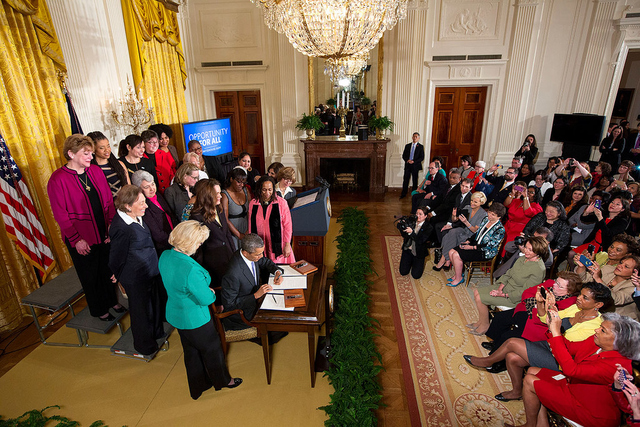The Obama PresidencyWomen's Issues in the Obama Era: Expanding Equality and Social Opportunity Under the Obama Administration
By
2015, Vol. 7 No. 02 | pg. 1/3 | »
IN THIS ARTICLE
In 1972, The Equal Rights Amendment was first introduced to Congress to protect an individual’s irrefutable equality of rights under the law regardless of sex. Although it passed both houses and failed to secure the necessary votes for state ratification, it is still a monumental achievement in the feminist movement for the momentum it created around equal rights. Four decades have passed since the ERA was proposed, yet the social and economic balance between men and women is still grossly skewed. This is first and foremost a matter of basic human rights, however this gap can have drastic economic implications if left unchecked, a reason why more and more policymakers, like President Barack Obama, are paying close attention. A common statistic tossed around in the political arena is that in 2014, women made about 77 cents for every dollar a man earned, performing equal work.1 Considering that two-thirds of families led by a single mother or two parents have women as the primary or co-breadwinner, this gap has a substantial impact on purchasing power, especially for those living below or near the poverty line. Obama’s actions since taking office in 2008 have improved women’s rights in the United States and ignited a public conversation around formerly stigmatized issues. In 2008, President Barack Obama was voted into office by historic margins of the female electorate. Campaigning on promises of a social safety net, reproductive rights, and equitable tax rates, Obama carried a 14-percentage point advantage among women. In 2012, the 20-point gender gap between candidate Mitt Romney and Barack Obama was the largest measured in any presidential election since 1952. Again, women overwhelmingly supported Barack Obama.2 It is natural to assume a correlation between this popularity and Obama’s emphatic promises to advance women’s rights, however basic Democratic economic ideals in favor of assisting the working poor played an equally important role. Upon his inauguration, President Obama made well on his promise and took immediate action to tackle social and economic advancement for the women that helped put him in office.In the 2014 State of the Union Address, Obama re-emphasized the importance of closing the gender gap, saying, “Today, women make up about half our workforce. But they still make 77 cents for every dollar a man earns. That is wrong, and in 2014, it’s an embarrassment. A woman deserves equal pay for equal work… Let’s work together – Congress, the White House, and businesses from Wall Street to Main Street – to give every woman the opportunity she deserves. Because I believe when women succeed, America succeeds.”3 To kick start this, he embraced a variety of initiatives that both explicitly and implicitly tackle female empowerment and gender equality. The first bill signed during his presidency was the Lilly Ledbetter Fair Pay Act in January 2009 to lengthen the statute of limitations for discriminatory pay claims. This landmark achievement propelled further action, giving rise to the proposed Paycheck Fairness Act in 2014. Although it failed to pass, its existence spoke to Barack Obama’s continued prioritization of the issue. In the area of women’s health, Obama’s sweeping healthcare reform in the form of the Affordable Care Act successfully ended discriminatory practices by insurance companies, ultimately expanding coverage to 8.7 million more women and increasing their access to preventative services.4 The Affordable Care Act, though not frequently branded as a gendered policy, has had enormous implications for women. Targeting wage inequality and economic marginalization, the President worked to create additional opportunities for women through clauses of the Recovery Act, and has repeatedly fought for an increased minimum wage, protection of Temporary Assistance to Needy Families (TANF) and expansion of the Earned Income Tax Credit (EITC).5 President Obama has been a vocal critic of domestic violence and sexual assault in response to the growing epidemic, paving the way for his national awareness campaign, “It’s On Us,” and the reauthorization of the Violence Against Women Act in 2013. To build on this, he created The Task Force to Protect Students from Sexual Assault and the White House Council on Women and Girls to institutionalize these efforts and leave a legacy after his presidency. This analysis will scrutinize President Obama’s promise to give every woman the opportunity she deserves and determine the extent to which he has been able to slim the gender gap and advance the social and economic status of women in the United States. The aforementioned initiatives embraced by the Obama administration are testament to the fact that gender equality has retained a top spot on the President’s priority list, even while many of his proposals have needlessly stalled in a highly bi-partisan legislature. Through a comparison of women’s advancements under previous administrations and an analysis of their progress from 2008 to 2014, I argue that Obama has effectively moved the needle forward for women by promoting social justice for all Americans in his rhetoric and his policies. Even if little happens in the realm of gender equality in the final two years of Obama’s presidency, it is safe to say that he has propelled an important national conversation around this issue that will succeed his time in office. Women in the 21st CenturyThe term “War on Women” gained traction in late 2011, detailing the efforts by Republican legislators to rollback women’s legal rights. Its origins are ironically traced back to a memoir published in 1996 by stalwart Republican Tanya Melich titled, “The Republican War Against Women.” This piece intended to draw attention to her party’s growing hostility towards modern women, even before the emergence of the anti-choice religious right took hold. Whether or not one gives credence to the War on Women depends to a large degree on his or her support for women’s reproductive legal rights; traditional conservatives are more likely to celebrate leaders like George W. Bush for his anti-choice agenda rather than view it as an affront to women. To accurately assess Barack Obama’s actions in this realm since 2008, it is necessary to look at events during the preceding Bush presidency. While it is possible to take this narrative back further, the events that took place during Bush’s two-term presidency should paint a clear picture of the scene Obama’s faced upon entering office. Through a variety of policies and proposals, Bush managed to rollback progress in economic security, access to opportunity, and health and reproductive rights for women, in effect reducing many hard-won legal rights. In direct contrast of Obama’s choice to embrace Lilly Ledbetter as his first major piece of legislation, on his first day in office, Bush re-imposed a rule instituted by Ronald Reagan barring health care providers receiving federal assistance from counseling women on abortion. Despite the campaign buttons in 2008 that read “W is for Women,” the Bush administration embraced a quiet approach to scaling back reproductive rights, strategically keeping their efforts out of the public eye. One example of this is the disappearance from all federal registers of guidelines put forth in 2001 around sexual harassment. Without publicly available federal policies around the enforcement of Title IX, schools could effectively avoid liability for violations. In 2002, Bush ended the Equal Pay Matters Initiative, a policy launched in 1999 to improve federal enforcement of pay discrimination, and avoided enforcing violations of equal pay laws. Unsurprisingly, there was a 25-50% drop in compliance reviews during his presidency.6Bush’s policies were particularly harmful to low-income women, because tax and budget cuts reduced key services and programs where women are the primary beneficiaries. For example, the Supplemental Nutritional Assistance Program (SNAP) was forced to cut 450,000 low-income women. Furthermore, Bush’s welfare reauthorization proposal required women receiving TANF to work double the hours per week, while at the same time opposing additional funding for childcare subsidies. Because most of these decisions put a halt to existing policies, rather than create new ones, Bush’s actions were perceived as less harmful. Retrospectively, one can see how this was a major step backward for women. Bush and his supporters cite the fact that he named five women to his cabinet, which although a positive achievement, does not take away from the fact that the majority of his cabinet espoused anti-female policies. Under Bush’s leadership, Attorney General John Ashcroft backed the Abortion Non-Discrimination Act to reduce the availability of abortion services offered by government-supported health care providers. Other laws endorsed by the administration categorically attacked Roe v. Wade; for example, the Unborn Victims of Violence Act proposed making it a criminal offense to harm an unborn child during a criminal act, and the Partial-Birth Abortion Act (signed into law) banned safe abortions as early as the 12thweek of gestation with no regard to the woman’s health. Perhaps his most public effort was that which tried to give a fetus, or even a fertilized egg personhood rights equivalent too, or even exceeding, that of a woman. In the years after his presidency, Bush has devoted resources towards health clinics in Zambia to combat cervical cancer and HIV/AIDS, saying “investing in women’s health is the right thing to do and thesmart thing to do.”7 This break from the Republican Party narrative is oddly similar to Obama’s stance on preventative healthcare for women. While this change of heart is applauded, it does not reverse eight-years of harmful policies that left Obama in a opportunistic position to turn the tables. Defining PrioritiesAlthough Democrats have championed the idea for years, Barack Obama popularized the notion that ensuring equal pay for work doesn’t just help women; it helps the whole economy. Women make up half of the workforce and hold the most household purchasing power, therefore promoting their equal participation in the economy will boost the well-being of families nationwide. Because wage discrimination lowers a woman’s lifetime earnings, her Social Security plans will inherently be lower, and she will have less money to spend on homes and the college education of their children. Moreover, the role of women in business is crucial to an organization’s health and success; considering that the top twenty-five Fortune 500 companies with the best female promotion records had return on assets 69% higher than competitors in their industry. Obama began linking the concepts of women’s empowerment and economic stimulation understanding that he would gain the support of women, as well as the broader American public, which was looking for any feasible proposal for repairing the economy. Part of this rhetoric may have been inspired by internal pressure to maintain his stronghold on the female electorate for the 2010 midterms; however, considering his successes, it seems as though he truly believed in this moral and economic rationale for equality. At the signing of the Lilly Ledbetter Fair Pay Act, Obama made his stance clear: “Making our economy work means making sure it works for everyone.”8 In 1998, Lilly Ledbetter, a female supervisor at Goodyear Tire and Rubber, filed a claim against sexual discrimination in the workplace after revelations that her salary was 40% lower than the lowest-paid male supervisor at the company.9 Although Ledbetter won the case and received 3.5 million in financial compensation for her losses, the decision was eventually overturned in 2007 due to ambiguous language around the statute of limitations period for filing sexual discrimination charges. The ostensibly straightforward idea that an employee must report unlawful employment practices within 180 days was disputed on the basis of time: does the clock starts when the pay decision is made, when the employee discovers the decision, or when she receives her paycheck? Theoretically, this meant that employers could admit to discriminatory wages without legal repercussion, as long as the wage decision occurred at least six months prior. The president and the public both recognized that embracing the Lilly Ledbetter Act as his first bill was remarkably symbolic of the themes he hoped to embody throughout his presidency of equality and opportunity. In response to Obama’s initiatives, the GOP contested that wage differences are often produced by factors other than gender, while in reality, studies show that women earn less than men holding all factors constant, including age, occupation, and education.10 While the extent of the gender wage gap is debated, multiple sources place it somewhere between 70-80%, with the U.S. Census supporting the claim that the average full-time working woman will earn 77 cents to a man’s dollar.11 Speaking to the wage gap, the President said, "this bill is an important step . . . I know that if we stay focused, as Lilly [Ledbetter] did - and keep standing for what's right, as Lilly did - we will close that pay gap and ensure that our daughters have the same rights, the same chances, and the same freedom to pursue their dreams as our sons.”12 The impact of these words and the legislation that supported them may not have seemed grandiose at the time, but in the year that this bill was signed, more than sixty court decisions directly referenced the Ledbetter case.13 To ensure a comprehensive approach, Obama went on to establish the National Equal Pay Enforcement Task Force in 2010 to support executive agencies tasked with monitoring equal pay enforcement. This strategy is vastly different than that of the previous Bush administration, which not only refused to embrace the wage gap as a real and present issue, but also declined to support amending the Equal Pay Act in 2008 due to the burden it would place on employers and the allowance of punitive damages for what they deemed “unintentional” pay decisions.14 This attitude is echoed in the GOP response to President Obama’s support for modification of the Fair Labor Standards Act, also known as the Equal Pay Act. If passed, these laws will increase the amount a plaintiff can be remedied in the form of compensatory damages for an equal pay case. The Ledbetter Act and an amended EPA will urge employers to critically assess their compensation structures or risk being prosecuted for past employment decisions. In April 2014, Obama signed Executive Order 13665, banning federal employers from penalizing employees for disclosing pay information to co-workers.15 Although only a fraction of women would benefit from the law, it was a small step in the right direction. Obama’s use of executive power arose in response to Republicans’ staunch disapproval of the Paycheck Fairness Act – a law which would expand this right to all employees – with the rationale that discriminatory pay is already illegal and need not be discussed further.16 In September 2014, Republicans blocked the legislation for a second time, and it remains unclear whether Obama will push for its passage a third time in his final two years. It will be interesting to see whether he embraces women’s issues without a pending 2016 reelection. President Obama has achieved major milestones with the passage of Lily Ledbetter, the enforcement of executive orders and fervent support for the Paycheck Fairness Act, however to fully close the wage gap, he must coerce the legislature to support the basic premise behind these initiatives.Continued on Next Page » Suggested Reading from Inquiries Journal
Inquiries Journal provides undergraduate and graduate students around the world a platform for the wide dissemination of academic work over a range of core disciplines. Representing the work of students from hundreds of institutions around the globe, Inquiries Journal's large database of academic articles is completely free. Learn more | Blog | Submit Latest in Women's & Gender Studies |



















